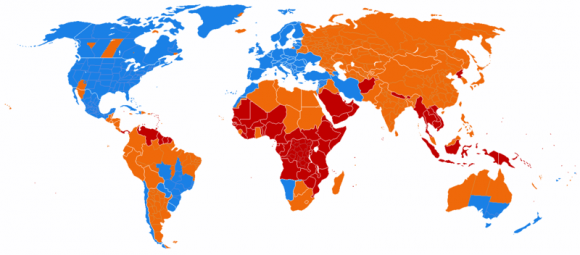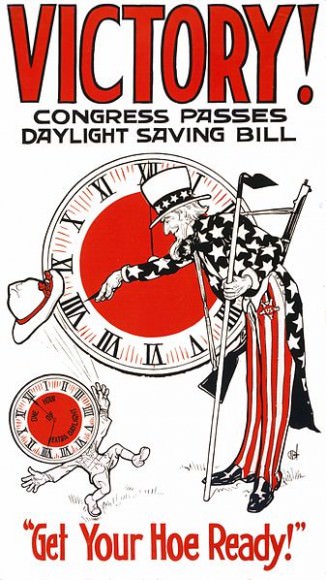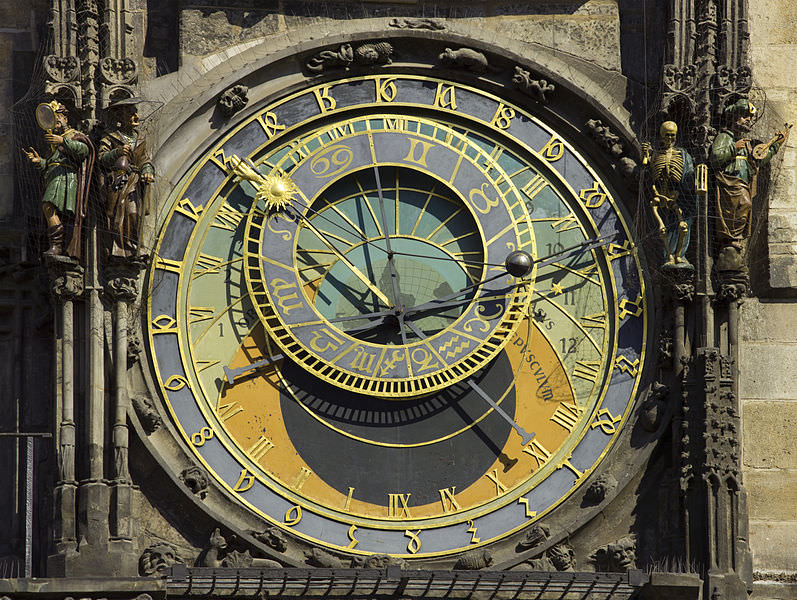The time to change clocks is once again nigh.
We’ll put our unabashed bias as a lover of the night sky right up front: we loathe Daylight Saving Time. And it’s not just because of the biannual hunt through our home for the dozen-odd non-networked clocks that it instigates twice a year. For astronomers, the shift to DST means that true darkness falls much later in the evening, marking the abrupt end of the school star party season not long after March. You don’t have to go far north to about latitude 45 degrees to find areas where it doesn’t get dark until about 11PM local towards mid-summer. And sure, we gain back an extra hour of morning darkness, albeit that too soon dwindles towards summer as well.
In 2014 we (as in a majority of North America) spring forward one hour on March 9th at 2:00 AM local. That’s just one day shy of the earliest that we can now spring forward, as the current convention established by the Energy Policy Act of 2005 during the Bush administration that was enacted in 2007 now sets the beginning of DST as the 2nd Sunday in March.
We’re now on DST for about roughly eight months or 67% of the calendar year. The European Union still shifts forward on the last Sunday of March, meaning that for a span of three weeks every March, the time lag between, say, Eastern Daylight Time and British Standard Time closes briefly to four hours before opening up again to five hours.

And that’s just for starters.
Of course, there are holdouts even among DST observing countries worldwide. The states of Arizona and Hawaii do not observe DST, nor did a portion of Indiana until 2006. When DST is in effect, you can touch on three time zones in just a few hours’ drive from southeastern Arizona crossing southern New Mexico and into Texas east of El Paso. And you can really mix things up driving across the Navajo nation in northeastern Arizona – which observes DST, unlike the rest of the state – into the Hopi Reservation embedded within it, which rejects DST.
In Canada, most of Saskatchewan ignores DST, as do small portions of British Columbia, Quebec and Nunavut. In 2011, Russia opted to remain on Daylight Saving Time year round, and Australia is sharply divided on the issue of keeping DST. Of course, in the southern hemisphere, astronomical spring and fall are reversed, making UK/US/Australia teleconference scheduling even more confusing this time of year, not to mention the often bewildering state of affairs faced by computer programmers seeking to include every new rule and nuisance concerning local timekeeping worldwide.

Most folks trace the notion of daylight saving time back to Benjamin Franklin, though DST saw its first implementation by Axis powers in 1916 as a cost saving measure. In the United States, the Standard Time Act of 1918 put DST into effect for the first time, and it was an on again, off again affair through most of the 20th century.
And it’s not just your imagination: we do spring forward earlier and fall back later in the year than we used to. The Uniform Time Act was amended in 1986 to begin DST on the first Sunday in April and run until the last Sunday in October. And as mentioned previously, the Energy Policy Act of 2005 modified this even further under President George W. Bush to our present state of affairs, starting DST on the second Sunday of March through the first Sunday in November.
The primary rational behind DST use is to cut energy consumption. Studies done by the U.S. Department of Transportation during the adoption of DST during the 1970’s OPEC Oil Embargo and the energy crisis showed a small but measurable net savings during the implementation of DST, as well as a small decrease in the crime rate. On the down side, many find it difficult to adjust their body clocks to the shift, with many morning commuters now confronted with darkness.
Is DST a conspiracy of the golf crowd and/or the candy lobby? Anecdotal tales abound that some senators simply wanted few more hours on the course each evening, and “Big Sugar” (a great pro-wrestling name, BTW) was all too willing to oblige. Certainly, we do our trick-or-treating in the daylight now on the last day of October, and will soon be waiting later and later each Sunday evening for astronomical darkness and the start of the Virtual Star Party.
But there are some rumblings of change. This year, Idaho is pushing to scrap DST altogether. And, as is the norm in the often curious state of Florida, lawmakers have proposed to swing even further in the other direction, with a bill dubbed the “Sunshine Protection Act” looking to put the entire state on permanent DST year round in hopes of increasing tourism.
And just last year, a failed White House petition brought up the issue of ending DST. Perhaps their misspelling of DST as “Daylight Savings” (a frequent mistake) detracted from its credibility. What is it that makes us just want to throw that spurious “s” in there?
And that’s the wacky state of time we’re stuck with. Yes, we’ll be ferreting out those non-networked clocks around Astroguyz HQ Sunday morning, bleary from the loss of an hours’ sleep.
Our modest proposal is to do away with DST and time zones entirely, and adopt the use of Universal Time (also referred to as Zulu or Greenwich Mean Time) across the board. I know, it’s a tall order. In the meantime, we’ll be saying #DownWithDST on Twitter, as we await true astronomical darkness at an ever later hour.
And with that, we’ll open the debate up to you, the astute and intelligent readership of Universe Today. Is Daylight Saving Time worth it?


Time to ditch DST. It doesn’t save anything anymore. Farmers, largely, ignore the clock. The livestock have internal clocks and know when it is time for feeding and such.
For about a week or two, everyone is dazed and confused and sleepy caused by the switches twice a year. Lost productivity and traffic accidents more than make up for any savings.
Most employers have “flex” time and so golfer’s can be accommodated.
Most of my life, I lived in Indianapolis and we did not observe DST from about 1966 till about 2007. An island of sanity in a sea of politicians tinkering with time.
Time Zones were invented to standardize time in places where more than one railway line. It was frequently the case that all the railroad stations of a railway company were on the time of the home office station. This meant that, for example, the St Louis railway station in Indianapolis would be on St Louis time and the Pennsylvania railway station in Indianapolis would be on Pennsylvania time. The area around a railway station usually adopted the time of the railway station. This worked well when there was only one railway in town but when multiple railways arose in an area, it was very confusing. The answer was time zones to standardize the time. This was proposed in 1883 and began to be used across the U.S. but it wasn’t made into law until 1918.
Then they got to tinkering with it again and came up with DST – in my opinion, a bad idea.
DST disrupts all of our biological clocks and makes us all lethargic, dull witted and HUNGRY at the wrong times for a week to a month. Some of us never really feel “right” until we revert back to our natural time.
Personally, I usually awaken with the sun and get sleepy when the sun goes down. This means I would get less sleep in the Summer and more sleep in the Winter if it weren’t for DST. Now I just can’t sleep at the “right” times because my internal clock is all messed up with DST.
DST is just a BAD IDEA!
Universal Time? Why not scrap duodecimal clocks altogether, like the French tried during the revolution? And the calendar, while we’re at it? We could just use Julian Dates, with decimals for time, like Captain Kirk’s log, star date 56721.8
Just forward the clock by 1/2 an hour in the spring and leave it that way permanently. That gives more light in the more and more light in the evening everybody gets a little something. No more having to adjust to the new time twice a year.
DST is good. It approximates what people and daytime waking animals do naturally: rise about the time of sunrise, earlier in summer and later in winter. We really don’t need it to be daylight at 4 AM, which is what would happen in June here if there were no DST.
Most employers actually DO care what time their employees start work, and those employees need the shift from winter time to summer time to happen in coordinated fashion so that their children’s school schedule, their bus to work, the stores they hope to drop by on the way home from work, all change at the same time. (If you’re lucky enough that your employer doesn’t care when you come in to work, why are you worried about DST? Just keep getting up at the same time and call it good.)
That said, I do think the spring change is too early. It would be nice if our change was at the same time as the European Union.
As for keeping coordinated universal time instead, people who need to use it already do: astronomers, other scientists. I don’t think you’re going to persuade anyone to abandon something approximating their local solar time. And it would leave a lot of problems. If I go to a city elsewhere, I still expect to find banks and post offices open at 9 AM in whatever time zone they’re in. If they keep CUT, I have to look up what time they open.
DST. You may like it when the full sun shines in your bedroom window at 5AM, I don’t. And as a kid it was always great to stay out late on those long summer nights.
It depends on where we are in the Time Zone. At N49 E19 we are almost an hour ahead of the time zone, DST makes sense, dawn would be too early in summer (3AM). In winter the 7AM dawn would be very depressing at 8AM.
Check this map of solar time vs. timezone time:
http://lawprofessors.typepad.com/property/2014/02/map-of-the-day-time-zone-v-solar-time.html
If you loathe DST, then why do you bother changing your clocks?!
As for GMT/UT, that is the best solution by far (OK, that’s easy for me to say as I live in the UK and remain on GMT/UT all-year round). 😉
I agree, it’s a daft idea to keep changing the clocks. Stick to DST or preferably Double DST all the year round! I hate these long dark evenings!! No stars here to look at, it’s always raining.
Unfortunately, Apple does not have a GMT/UTC setting for my Ipod — only a “London” setting. So, it changes to London Summer Time. I have to set it to “Reykjavik” to get UT.
Let’s get rid of DST. It’s not just an idea that’s past its time, it’s dangerous. Injuries in risky industries like mining soar the week after DST goes into effect.